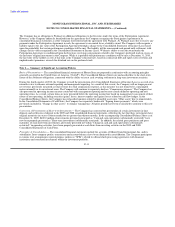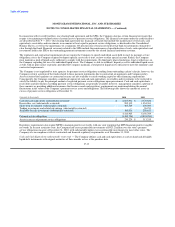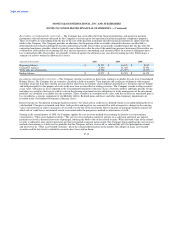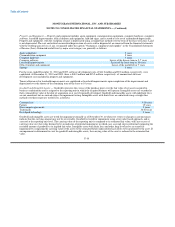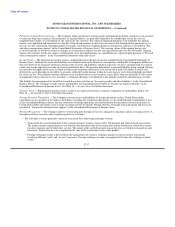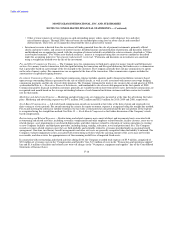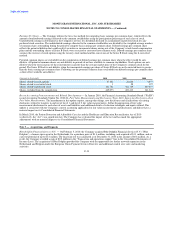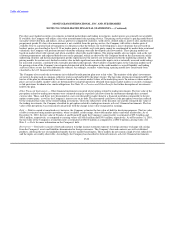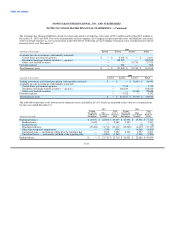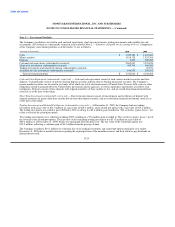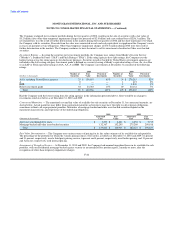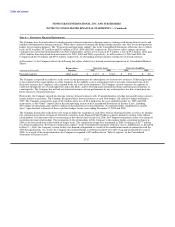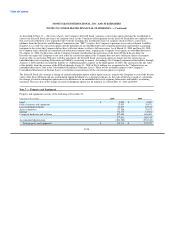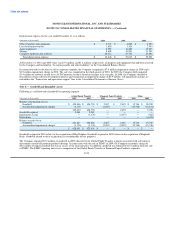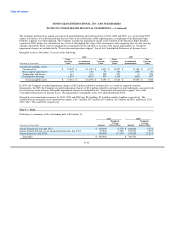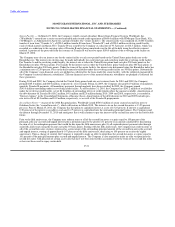MoneyGram 2010 Annual Report Download - page 106
Download and view the complete annual report
Please find page 106 of the 2010 MoneyGram annual report below. You can navigate through the pages in the report by either clicking on the pages listed below, or by using the keyword search tool below to find specific information within the annual report.
Table of Contents
MONEYGRAM INTERNATIONAL, INC. AND SUBSIDIARIES
NOTES TO CONSOLIDATED FINANCIAL STATEMENTS — (Continued)
In 2009, the Company finalized its purchase price allocation, resulting in goodwill of $4.3 million assigned to the Company's Global
Funds Transfer segment and $1.4 million of intangible assets. The intangible assets consist primarily of customer lists and developed
technology and are being amortized over useful lives ranging from three to five years. In addition, the Company recognized an indefinite
life intangible asset of $0.6 million relating to the money transfer license. The purchase price allocation includes $0.5 million of
transaction costs. The operating results of MoneyCard and Cambios Sol subsequent to the acquisition dates are included in the
Company's Consolidated Statements of Income (Loss). The financial impact of the acquisitions is not material to the Consolidated
Balance Sheets or Consolidated Statements of Income (Loss).
Property Bridge — After evaluating the Company's market opportunity for certain of its electronic payment services, the Company
received approval from its Board of Directors in January 2011 and began to actively pursue the sale of Property Bridge in February 2011.
Assets, liabilities, revenue and expenses related to Property Bridge are immaterial to the Consolidated Balance Sheets as of December 31,
2010 and the Consolidated Statements of Income (Loss) for the year ended December 31, 2010.
Other Disposals — During 2010, the Company completed the sale of its corporate airplane with net proceeds of $7.5 million. Upon
completion of the sale in the third quarter of 2010 the Company recorded an impairment charge of $1.5 million. In 2009, in connection
with this decision to sell the airplane, the Company recognized a $7.0 million impairment charge. Impairment charges are recorded in the
"Transaction and operations support" line in the Consolidated Statements of Income (Loss).
Note 4 — Fair Value Measurement
The Company records certain of its assets and liabilities at fair value. Fair value is defined as the exchange price that would be received
for an asset or paid to transfer a liability, or the exit price, in an orderly transaction between market participants on the measurement date.
A three-level hierarchy is used for fair value measurements based upon the observability of the inputs to the valuation of an asset or
liability as of the measurement date. Under the hierarchy, the highest priority is given to unadjusted quoted prices in active markets for
identical assets or liabilities (Level 1), followed by observable inputs (Level 2) and unobservable inputs (Level 3). A financial
instrument's level within the hierarchy is based on the lowest level of any input that is significant to the fair value measurement.
Following is a description of the Company's valuation methodologies for assets and liabilities measured at fair value:
Investments — For United States government agencies and residential mortgage-backed securities collateralized by United States
government agency securities, fair value measures are generally obtained from independent sources, including a pricing service. Because
market quotes are generally not readily available or accessible for these specific securities, the pricing service generally measures fair
value through the use of pricing models and observable inputs for similar assets and market data. Accordingly, these securities are
classified as Level 2 financial instruments. The Company periodically corroborates the valuations provided by the pricing service through
internal valuations utilizing externally developed cash flow models, comparison to actual transaction prices for any sold securities and
any broker quotes received on the same security.
F-21


